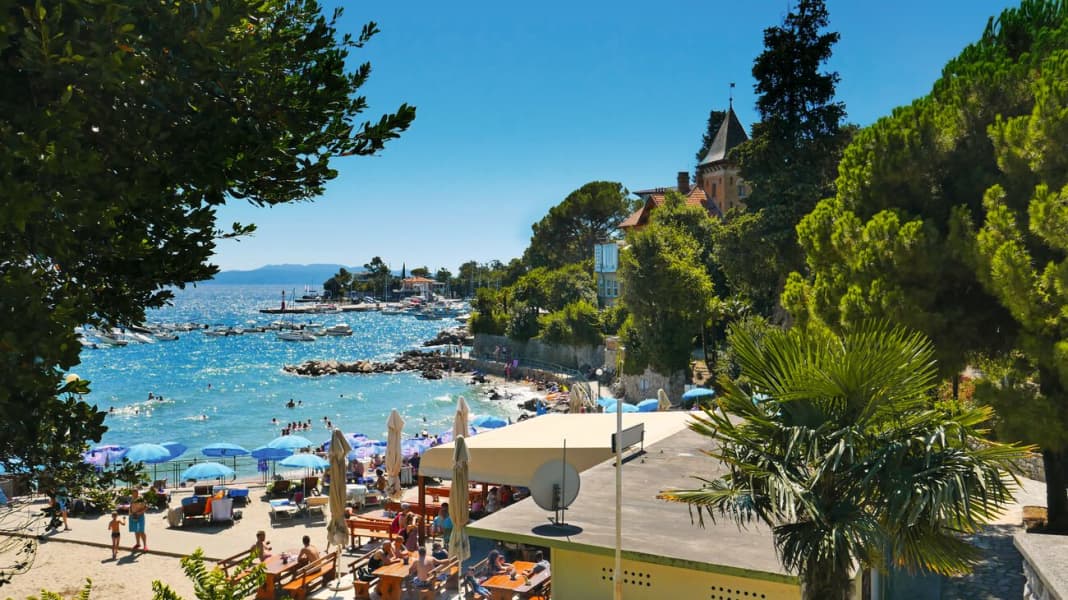
After almost two years of involuntary pause due to the pandemic, our "Azura" is back in the waters of the Mediterranean. Technicians are repairing the numerous consequences of the shutdown. There is a reason for this: ships simply age much faster here than at home. While we would have spent at least six winter months indoors there, "Azura" was exposed to the weather the whole time down here due to a lack of accommodation. On the northern Adriatic this means, on the one hand, intense heat and sunshine in the summer months. On the other hand, the strong storms in autumn and winter (bora) tear at everything that is not nailed down. So there is plenty to repair, mend and replace. However, the entire Croatian Adriatic now lies ahead of us. At last we're off again!
The first stages take us from Lignano to Trieste and then on to Istria, initially with a spontaneous stopover in Piran, Slovenia, before we finally make our way to Croatia. We actually get a wonderful berth in this picturesque little harbour, and we enjoy this evening in an atmosphere that still has a strong Italian flavour. The contrasting programme awaits us the next day in Umag: although Croatia has been a member of the EU since 2013, it has yet to join the Schengen area. This means, as in the past throughout Europe: clearing in with various entry formalities. Firstly, you have to wait for a free space at the immigration authorities' jetty - and sometimes even fight off people pushing in front of you. Then you have to show your passports to the police and fill in a crew list, which is stamped. Corona vaccination data must also be presented. Then it's off to customs, where the building itself is reminiscent of the socialist past. The ship's papers and crew list must be presented there. Then it's the turn of the vignette, the price of which depends on the size of the boat and engine.
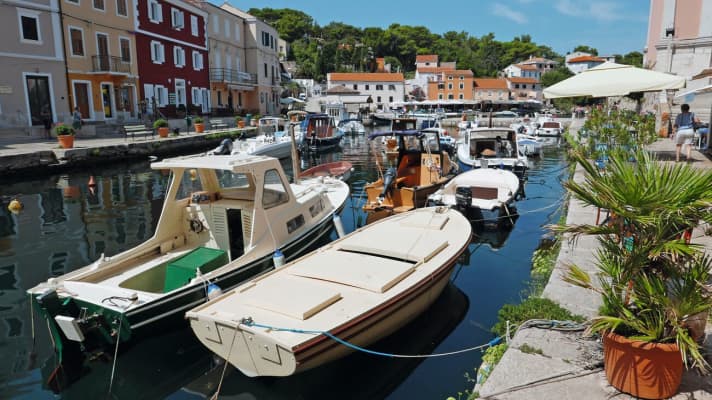
In our case, this amounts to the proud sum of 909.13 euros. Card payment no thanks - please pay in cash in the local currency kuna or, if necessary, in euros. As I don't usually walk around with that much cash in my wallet, good advice is expensive at first. But I eventually find an ATM at the bottom of the building. Only later do I discover on the receipt that not only was the exchange rate quite poor, but that an exchange margin of 13 per cent was also charged. You are very welcome!
From Umag, however, we are already heading for our first Croatian dream destination: Rovinj. Rovinj was originally its own island, which was only connected to the mainland in 1763. The varied history with its numerous and diverse rulers has strongly characterised the townscape. Built on a hill jutting out into the sea, the old town centre with its winding alleyways and Romanesque-Gothic townscape has numerous Renaissance, Baroque and neoclassical elements. Anyone with a heart for romance will be in their element here. The relatively new ACI Marina Rovinj has no space problems with us and can also accommodate much larger yachts. However, the size, location and service come at a price. We have to swallow a little when we are asked to pay a daily fee of over 600 euros before we leave. Even in the high season, this is extreme by Mediterranean standards and is significantly higher than the prices we have seen on the mainland coast of Spain, France and Italy. Only world tourist hotspots such as Ibiza, Portofino and Capri allow themselves even higher prices, which are out of all proportion to the services on offer.
However, ACI (Adriatic Croatia International Club) is generally a very good and professional address. The organisation of this marina chain currently includes 22 marinas in all parts of Croatia, several of which we will call at during our trip. The information on the Internet is excellent and the prices are not obscure - quite the opposite. You just have to look carefully, which we will be doing regularly from now on. All the ACI marinas we visited are of different sizes and generally have a completely different price level to Rovinj.
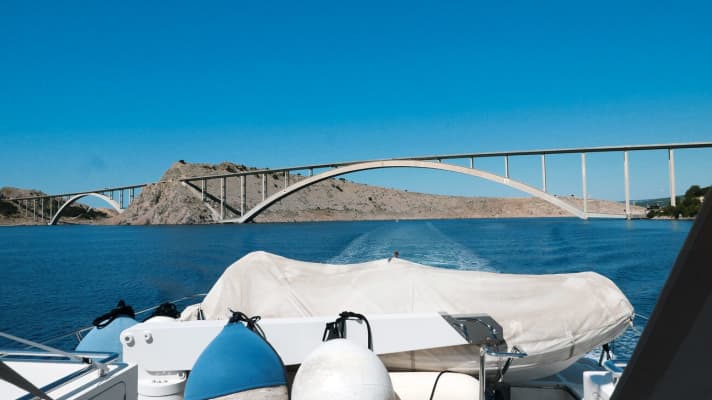
Almost at the southern tip of Istria lies Pula - the largest city in Istria with over 50,000 inhabitants, which can also be approached by plane. However, the well-protected natural harbour has a rather industrial feel to it, which even the city's landmark - an amphitheatre built under Emperor Augustus and reminiscent of the Roman Colosseum - can't quite make up for. At the end of the day, we end up in Marina Veruda, a little further south in an elongated natural bay. There we are spoilt with culinary delights once again.
The next morning brings some wind and swell for the first time after days of uninterrupted smooth seas. We immediately feel at home again and really enjoy the familiar sea atmosphere with a bit of rolling and the occasional splash of spray up to the flybridge. Our destination is now the ACI marina in Opatija - small but beautiful, protected by mountains and with mooring alongside for a change. As we have never been to Yugoslavia before, everything here is new to us. This includes the realisation that there is even something of a "Croatian Riviera" in this corner of Croatia, with fantastic villas by the sea and impressive seaside resort hotels.
The stretch of coast between Lovran and Opatija is reminiscent of the Côte d'Azur. The twelve-kilometre-long Franz Joseph Promenade - also known as the Lungomare - was built between 1889 and 1911 and connects these coastal towns. We hire a car and drive into the nearby mountains. At an altitude of over a thousand metres, it is much colder than by the water. After coffee and cake in the Dopolavoro restaurant on Mount Učka, we drive further inland. There we visit the Vela Draga canyon - a protected area since 1963 with limestone columns and rocks over one hundred metres high. During a stopover on the way back, we have another marvellous panoramic view of the sea below, decorated with whitecaps by the bora, all the way to Rijeka from the little village of Brseč.

Rijeka is a large industrial city with around 130,000 inhabitants and was the European Capital of Culture in 2020 - unfortunately prevented by Corona. The lively and busy city centre has an appealing mix of old and new buildings interspersed with alleyways and passageways. A metropolitan crowd populates the numerous cafés, and you should also pay a visit to the market halls: they are a Mecca for fish lovers, with many seafood products on offer that are largely unknown here at home.
After the bora has calmed down again, we set our sights on Marina Punat on the island of Krk. Instead of taking the direct route to the south-east and past the island of Cres, we choose a diversion: our route takes us through the northern part of the Velebit Channel, also known as the Vinodol Channel. The Velebit Channel is a strait in the upper Adriatic Sea between the Croatian mainland and the offshore islands and is around 130 kilometres long. It is one of the most dangerous waterways in the world due to the frequently occurring bora winds, combined with a local jet effect from the Velebit mountains. In winter, peak wind speeds of up to 240 kilometres per hour have been measured there in places - that's twice wind force 12! By comparison, the notorious Cape Horn has wind speeds of just 160 kilometres per hour. Even though we are a long way from such life-threatening conditions during our passage, after crossing the double bridge to the island of Krk, the previous calm quickly turns into a strong wind of up to five to six Beaufort. The wave reflections from the partly vertical rock faces mix with the swell generated by the strong winds and cause the spray from these small cross seas to splash onto the flybridge in glorious sunshine. This gives us a hint of what can happen here in winter.
Otherwise, Croatian waters have numerous advantages: For one thing, the density of harbours, marinas, anchor bays and mooring buoys is enormous - possibly unique in the world. So you can always find a sheltered spot within a manageable distance. On the other hand, the fragmented coastal structure with its large number of islands offers different wind and sea conditions in otherwise identical weather conditions. If it is too rough in front of a chain of islands, calm may be waiting behind it. At the same time, nature offers spectacular scenery with high mountains, deep gorges and green islets that have been shorn bare by the bora.
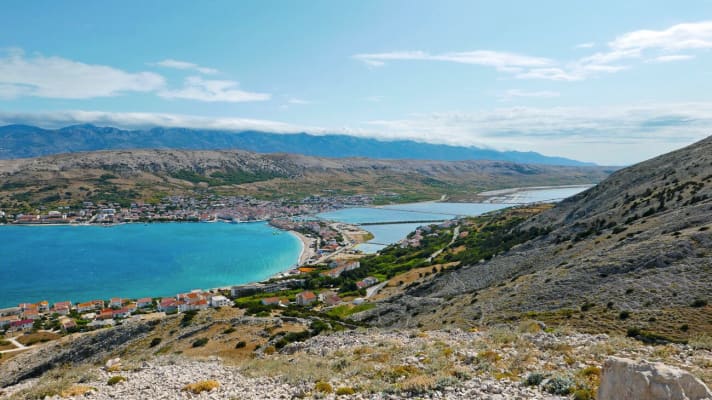
Marina Punat, which is very well-known and popular in Germany, is located in a natural bay on the southern edge of the island of Krk. A jetty was built here back in 1963. Today there are over 1300 berths, a shipyard, a charter service, restaurants, a supermarket and a wellness hotel. Due to the sheltered location, the boats can stay in the water in winter, but land moorings are of course also possible. Next to us is another German motor yacht whose owners have been customers here for 43 years. Among other things, they speak very good German here, which makes communication much easier.
We also unpack our dinghy here after a two-year break. The tarpaulin feels like brittle parchment and has a hole in it due to wear and tear, but apart from dust and dirt, everything else is in order. The outboard starts immediately. So we set off full of confidence for a "test drive" in ideal sea conditions to the main town of Krk. After some searching, we find a jetty and pay a visit to the touristy old town.
In glorious summer weather, we now head south to the island of Losinj. We are advised not to take the short Privlaka Canal with its swing bridge, which opens twice a day, because of the size of our boat. Instead, we circumnavigate the island of Losinj at its southern end and then, after a strong headwind and salty spray over the ship, enter the excellently protected natural bay. At the end of the bay lies the main town of Mali Losinj, which nestles gently against a mountainside and looks inviting from afar. We are given an excellent berth close to the town and yet far enough away from the hustle and bustle.
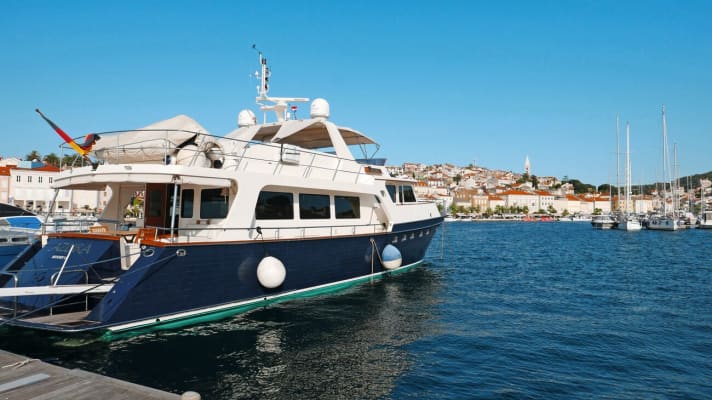
The next morning we drive to Veli Losinj, which means "Big Losinj" in German. However, the proportions of the two Losinj islands have been massively reversed since the village was founded. Veli Losinj has a tiny, deeply cut natural harbour whose layout and surrounding buildings could not be more beautiful. At the tip of the small harbour basin, small boats bob in front of restaurants and a church, while a yacht is moored on the quay in front of the Ribarska Koliba tavern. That would also be an incredible berth for us, I think to myself.
So we decide to stop off at the konoba for a light lunch and - last but not least - to enquire about the mooring options. It soon transpires that the quay is under municipal management and that a certain Filipe is the harbour master there. The Swedish crew of the yacht confirms this information - now we just have to find Filipe. When we finally manage to do so, however, he turns out not to be very decisive. In the end, however, I hear more of a no than a yes and walk back to our restaurant, slightly disappointed about my shattered dream.
Our next destination is Marina Simuni on the island of Pag with its hills shorn bare by the bora. We want to weather the forecast storm there and explore the island at the same time. We learn that the main town of Pag was actually built three times: The first sank into the water after an earthquake, and a church still remains from the second, "old" Pag. Today's "new" Pag lives from tourism, viticulture, fishing and salt production. The large salt works is still in operation, and a museum shows the history of this formerly wealthy industry. Pag also produces a very tasty cheese, Paški sir, and olive oil from olive trees that are over a thousand years old. The production of sewing lace also has a long tradition - Pag lace is therefore a popular souvenir.
Two days later, we finally arrive in Zadar in marvellous conditions. As we couldn't get a berth for two days in the marina directly in front of the old town, we moored in the slightly more distant Borik marina. Here we are helped by the misfortune of another boat owner who had to take his 30-metre Ferretti to the boatyard due to engine problems. We are given his berth right at the harbour entrance with a wonderful unobstructed view across the water to the hills of the island of Ugljan. As the general weather situation in Europe is currently changing and cold air from the north is being pumped into Croatia by a huge low-pressure system, the temperatures drop by 5 to 10 °C, which is not unpleasant for us. We can finally sleep without air conditioning again!
The travelogue " Oh, Adriatic Sea!" can be found with more pictures in BOOTE issue 06/2022 - on newsstands since 18 May 2022 or online directly in the Delius Klasing Shop.

